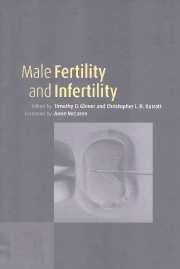Book contents
- Frontmatter
- Contents
- List of contributors
- Foreword by Anne McLaren, FRS
- Preface
- Acknowledgements
- Part 1 Biological perspectives
- Part 2 Implications of the new technologies
- 8 ICSI: the revolution and the portents
- 9 The genetic basis of male infertility
- 10 The treatment of azoospermia with surgery and ICSI
- 11 The challenge of asthenozoospermia
- 12 Molecular techniques for the diagnosis of inherited disorders and male reproductive malfunction
- 13 Gazing into the crystal ball: future diagnosis and management in andrology
- Index
10 - The treatment of azoospermia with surgery and ICSI
from Part 2 - Implications of the new technologies
Published online by Cambridge University Press: 09 August 2009
- Frontmatter
- Contents
- List of contributors
- Foreword by Anne McLaren, FRS
- Preface
- Acknowledgements
- Part 1 Biological perspectives
- Part 2 Implications of the new technologies
- 8 ICSI: the revolution and the portents
- 9 The genetic basis of male infertility
- 10 The treatment of azoospermia with surgery and ICSI
- 11 The challenge of asthenozoospermia
- 12 Molecular techniques for the diagnosis of inherited disorders and male reproductive malfunction
- 13 Gazing into the crystal ball: future diagnosis and management in andrology
- Index
Summary
ICSI for oligoasthenospermia
Before 1992, male infertility had been considered in most cases to be untreatable. Then came a surprisingly neat solution: ICSI, i.e the injection of a single spermatozoon into a single egg. Since the publication of the first papers on ICSI for oligozoospermia in 1992 and 1993, an intense flurry of scientific effort has been dedicated to extending its application to virtually every type of male infertility (Palermo et al., 1992; Van Steirteghem et al., 1993; Silber, 1995; Silber et al., 1995a). First it was confirmed that the most severe cases of oligoasthenoteratospermia enjoyed the same success rates as mild cases of male factor infertility and that these pregnancy rates were no different from those of couples where men with normal spermatozoa were undertaking conventional IVF (Nagy et al., 1995a). Next, it was discovered that it does not really matter how the spermatozoon is pretreated prior to ICSI, and that any method for aspirating the spermatozoon into an injection pipette and transferring it into the oocyte is adequate (Liu et al., 1994a). In fact, no sperm defect precluded success with the ICSI technique. Any fertilization failure was always related either to poor egg quality or to sperm nonviability (Liu et al., 1995). It appeared that there was no negative effect on the pregnancy rate with ICSI even with the most severe morphological sperm defects, the most severe reduction in motility, or with the tiniest number of spermatozoa in the ejaculate (‘pseudoazoospermia’) (see Tables 10.1 and 10.2).
- Type
- Chapter
- Information
- Male Fertility and Infertility , pp. 180 - 190Publisher: Cambridge University PressPrint publication year: 1999



